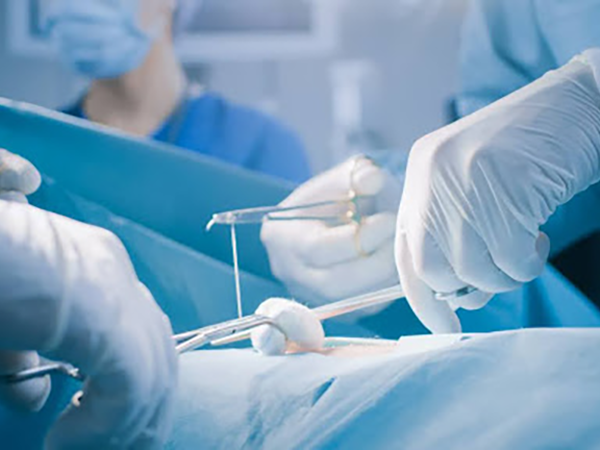 Surgery is inherently complex, and yet, many of the most important concepts and mechanisms that make procedures a success are simple. Sutures, for example, have existed in some capacity for millennia, with humans long aware that wounds would heal more quickly and with a lesser chance of infection if they were somehow closed.
Surgery is inherently complex, and yet, many of the most important concepts and mechanisms that make procedures a success are simple. Sutures, for example, have existed in some capacity for millennia, with humans long aware that wounds would heal more quickly and with a lesser chance of infection if they were somehow closed.
This basic concept still underscores the mighty suture and, while the materials and the processes for applying them have changed over time, their purpose remains the same as ever. We may, however, be on the cusp of a major leap forward in suturing technology.
The developments currently underway promise to usher in a new era in surgery, with fewer infections and reduced inflammation. Below, we will cover the impressive past, present, and future of the humble suture, revealing just how far we’ve come and how far this important form of surgical technology can go moving forward.
What Is a Surgical Suture?
Commonly referred to by the public as stitches, sutures involve the various tools and techniques used by medical professionals to close wounds by holding body tissues close together. These differ from other closure methods such as staples or glues in that they provide greater tensile strength.
As a report in the Aesthetic Surgery Journal explains, the word suture is derived from the Latin term sutura, which means “a sewn seam.” When it comes down to it, suturing is essentially a form of sewing, albeit with a sterilized needle and human tissues. The stakes are higher, of course, but the concepts remain similar: A needle and thread are used to make stitches that ultimately attach two edges and keep them together.
What Is the Purpose of Surgical Sutures?
Surgical sutures serve many important functions in modern medicine. Above all else, they facilitate healing while reducing the risk of infection. Achieving closure is important because of the skin’s vital role as a barrier to block harmful bacteria.
While many strategies are available for closing wounds, sutures are often preferred because they deliver exceptional strength and are less likely to suffer a phenomenon known as dehiscence, in which the previously closed wound edges separate partially or entirely.
What Is the History of Sutures?
Throughout history, a variety of wound closure solutions have resembled the suture strategies we recognize today. Thousands of years ago, eyed needles were used to pass sutures through wounds. The needles were often constructed from bone, while the sutures could be made from a variety of materials, such as grass, hemp, linens, or even pig bristles.
The takeaway is that primitive people were able to perform a variety of surgical procedures. From there, we can infer that humans have a remarkable capacity for conceiving of and providing medical treatments. As our technology has advanced (and especially our understanding of infection), we have been able to build on these early successes and save countless lives through the simple power of suturing.
Historical Start Around 1600 BCE
While historians believe that the experimentation that led to the widespread use of sutures began around 3000 BCE, concrete evidence of their usage can be traced back to 1600 BCE, based on a papyrus acquired by Egyptologist Edwin Smith in 1862.
Now regarded as the civilization’s oldest known surgical text, the papyrus was translated by fellow Egyptologist James Henry Breasted during the 1920s and published in two volumes containing both the translation and commentary. Many of the cases described in the papyrus highlight the use of sutures. For treating lacerations, for example, the papyrus advises drawing the gash together with strips of linens.
Indian surgeon Sushruta expanded on ancient suturing literature in 500 BCE with the Samhita, which is widely regarded as a foundational text for the practice of Ayurveda medicine. This text highlighted the use of the sheep’s upper small intestine as a suturing material for procedures such as amputations and tonsillectomies.
By the Middle Ages, cautery had largely overtaken suturing as the standard of care for treating wounds, although many surgeons from this period still expressed an understanding of and appreciation for the suture.
1867: Lord Joseph Lister Pioneers Antiseptic Surgery
Suturing saw few advancements during the Middle Ages or the Renaissance but was eventually revived. The next big breakthrough occurred in the 1860s, when British surgeon Joseph Lister began performing experiments in hopes of demonstrating that microorganisms were responsible for wound infections. He worked with carbolic acid (also known as creosote) to disinfect compound fractures. Many of these remained free of infection, which, at the time, represented a huge improvement given the horrific rates of sepsis in hospitals of the 1800s.
How Have Sutures Improved?
The basic concepts that underscore sutures have largely remained stable since the breakthroughs of the late 1800s, but these days, we enjoy access to a wider range of solutions for addressing common concerns such as infection and inflammation.
We’ve moved beyond carbolic acid to emphasize sterile techniques, but many of Lister’s recommendations remain as relevant as ever: washing hands and wearing clean gloves, for example. Further improvements worth noting include:
Sterile Suture Created
Sterile sutures provided one of the most impactful advancements in surgical techniques, and, again, Lister deserves credit for moving the science forward. He developed early protocols for sterilizing instruments and otherwise limiting exposure to potentially harmful bacteria. The sutures themselves, however, must also be sterilized.
Johnson & Johnson offered a solution in 1887 with the creation of sterile catgut and silk sutures. Historian Margaret Gurowitz explains that, once these were introduced, “patient survival rates in American hospitals skyrocketed.”
Synthetic sutures provided another step forward, as the pioneer Ethicon unveiled a sterile suture constructed from polypropylene. The company’s franchise medical director Liza Ovington, PhD, explains that this still represents the preferred solution for bypass surgery, saying it’s “a favorite for cardiovascular surgeons because it stretches easily and doesn’t tear.”
Sterilize by Radiation
Again spurring a major advancement for sterilized suturing, Ethicon introduced radiology as a sterilization strategy in 1960. Gamma radiation is a reliable sterilization strategy for many types of medical devices and equipment, as the gamma rays can produce a high-penetrating energy capable of decimating potentially harmful microorganisms.
Another distinct advantage of radiation? The possibility to sterilize sealed medical products. There are some limitations worth addressing when sutures are involved, however, as these strategies may not be suitable for catgut or polypropylene sutures.
2000s: Antibacterial Sutures Created
The early 2000s saw the introduction of antibacterial sutures, which, to start, were constructed from polygluconic co-lactic acid (PGLA). Incorporating the antibacterial agent Triclosan, this revolutionary suture dramatically reduced the rates of surgical site infections. Research credits these reductions to Triclosan’s ability to prevent bacterial colonization, as explained in the peer-reviewed journal BMJ Open.
Dermabond
A topical skin adhesive containing 2-Octyl cyanoacrylate, Dermabond can be used to glue the sides of injuries or incisions. Often used in place of stitches to treat small lacerations or incisions, Dermabond is highly sterile and therefore, an excellent option for reducing the risk of infection. It can also be used alongside deeper dermal stitches. When these techniques are integrated, optimal wound-closing strength is achieved.
The original topical adhesive cleared by the FDA was released in 1998, but this was followed in 2014 by the Dermabond Prineo system. Featuring liquid adhesive and self-adhering mesh, the Prineo solution expands on the microbial barrier created by the original Dermabond to deliver an even better healing environment and impressive cosmetic outcomes.
Absorbable vs. Non-Absorbable
A variety of factors can be used to classify sutures, but the most common form of categorization involves absorbable versus non-absorbable methods. These different types of sutures present distinct advantages and concerns, and what’s preferred for one type of surgery may prove less than ideal for another.
Absorbable Sutures
Sutures that lose much of their tensile strength within a few weeks or months can be classified as absorbable. These types of surgical sutures are advantageous in situations that would otherwise make removal difficult, such as when dealing with deeper wounds or healing during multi-layer closures. With surface-level wounds, however, absorbable sutures may increase the risk of infection.
Absorbable sutures have traditionally been composed of natural materials, with the aforementioned catgut representing the standard of care for millennia.
There are also a few synthetic absorbable options worth mentioning, such as polyglycolic acid (PGA) and poly-lactic-co-glycolic acid (PLGA). PGA is known for its high tensile strength, while PLGA can functions as a biodegradable suture material and a solution for drug delivery.
Non-Absorbable Sutures
Available in both synthetic and natural forms, non-absorbable sutures are, as the Journal of Functional Biomaterials points out, “characterized by the resistance to biodegradability.” These sutures are known for their strength but also can be desirable due to their lack of inflammatory responses and their resistance to infection.
While non-absorbable sutures are typically associated with synthetic materials, a few natural solutions are available: silk and cellulose. Silk sutures are easy to handle on the surgeon’s end but also comfortable for the patient. Cellulose sutures are cost-effective but also boast excellent tensile strength.
There are three main options for synthetic non-absorbable sutures:
- Polyester. Impressive strength lends polyester sutures a distinct advantage, but these unfortunately can pose a higher risk for infection. Polyester sutures can prove beneficial when there is a need to pass through tissues with greater ease
- Polyamide. Elasticity and abrasive resistance represent key advantages of polyamide sutures, which are smooth and known for their remarkable knot security.
- Polypropylene. Offering decent flexibility and high tensile strength, polypropylene sutures are frequently used in closure areas that are prone to tension. These offer long-lasting support while minimizing tissue irritation and inflammation.
What Does the Future Hold For Sutures?
The future is bright for suture technology, with a variety of new techniques promising to facilitate even faster healing while keeping inflammation and infections to a minimum. Rapid advancements in materials science and bioengineering have facilitated many of the most recent improvements, delivering what the journal Acta Biomaterialia refers to as marked increase in multi-functionalization.
Moving forward, technological advancements will provide more impactful suturing materials, as well as cutting-edge techniques for training, coaching, and assessment of suturing. Meanwhile, innovations such as barbed sutures could pave the path for robotic-assisted surgical systems. These may be better capable of completing sutures in tight spaces, allowing for minimally invasive surgeries and superior healing.
What Are Smart Sutures?
One of the most exciting advancements in suturing technology is the development of smart sutures, which play heavily into the aforementioned concept of multi-functionalization. Sometimes referred to as electronic sutures, smart sutures make use of a specialized coating and tiny electronic sensors, which provide valuable insight into everything from gastric leakage to wound integrity.
Some sutures are even capable of releasing drugs. These solutions hold many exciting possibilities, such as swifter healing for Crohn’s disease patients after they undergo surgery. Meanwhile, sutures that change color may help to reveal infection early on. Future improvements will allow for greater operating depths, making it possible to monitor deeper tissues and organs.
Embrace the Future of Sutures
Learn more about surgical assisting by exploring the Surgical Technology program at Carrington College.
Sources:
- Byrne, M. “The Surgical Suture.” Aesthetic Surgery Journal.
- Muffly T. et al. “The history and evolution of sutures in pelvic surgery.” Journal of the Royal Society of Medicine.
- Levin, H. “Stitch in Time: 18 Fascinating Facts About the History of Sutures.” Johnson & Johnson.
- Ahmed, I., et al. “The use of triclosan-coated sutures to prevent surgical site infections: a systematic review and meta-analysis of the literature.” BMJ Open.
- Choi, Y. et al. “Biomechanical Properties and Biocompatibility of a Non-Absorbable Elastic Thread.” Journal of Functional Biomaterials.
- Li, Y., et al. “Advances, challenges, and prospects for surgical suture materials.” Acta Biomaterialia.



